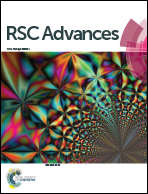ZnO nanoplates assembled by rod-like nanoparticles: simple reflux synthesis, influential factors and shape evolution towards nanorings
Abstract
ZnO nanoplates assembled by abundant rod-like nanoparticles have been successfully prepared by a simple reflux route without the assistance of a structure-directing agent or template. The as-synthesized products were characterized by X-ray diffraction (XRD), scanning electron microscopy (SEM), (high resolution) transmission electron microscopy (HRTEM/TEM), selected area electron diffraction (SAED), UV-vis diffuse reflectance spectroscopy (DRS) and photoluminescence spectroscopy (PL). Some factors influencing the morphology of the ZnO nanostructures were investigated, including the type of polyol and Zn2+ ion source, the amounts of zinc nitrate hexahydrate and hexamine, and the reaction temperature. It was found that the volume ratio of diethylene glycol and water in the system played a crucial role in the formation of ZnO nanoplates. The time-dependent shape evolution experiments revealed that under the present experimental conditions, the formation of the ZnO nanostructures underwent a transition from nanoparticles to nanoplates, and finally to nanorings. Experiments showed that the as-obtained ZnO nanostructures presented good visible-light photocatalytic activity and a wide range of PL properties.


 Please wait while we load your content...
Please wait while we load your content...